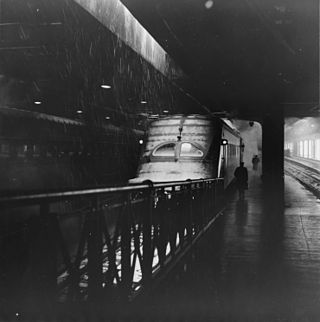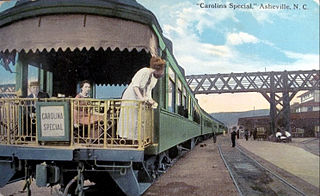
The Hiawathas were a fleet of named passenger trains operated by the Chicago, Milwaukee, St. Paul and Pacific Railroad between Chicago and various destinations in the Midwest and Western United States. The most notable of these trains was the original Twin Cities Hiawatha, which served the Twin Cities in Minnesota. The train was named for the epic poem The Song of Hiawatha by Henry Wadsworth Longfellow.

The 400 was a named passenger train operated by the Chicago and North Western Railway between Chicago and Saint Paul, with a final stop in Minneapolis. The train took its name from the schedule of 400 miles between the cities in 400 minutes, and was also a nod to "The Four Hundred Club", a term coined by Ward McAllister to refer to the social elite of New York City in the late 19th century. It was an express train with limited stops between Chicago and the Twin Cities. The "400" ran from 1935 to 1963 on the Chicago to Twin Cities route. The C&NW later named their other passenger trains using the number "400".

The Empire State Express was one of the named passenger trains and onetime flagship of the New York Central & Hudson River Railroad. On September 14, 1891, it covered the 436 miles (702 kilometers) between New York City and Buffalo in 7 hours and 6 minutes, averaging 61.4 miles-per-hour (98.8 km/h), with a top speed of 82 mph (132 km/h).

The Cincinnatian was a named passenger train operated by the Baltimore and Ohio Railroad (B&O). The B&O inaugurated service on January 19, 1947, with service between Baltimore, Maryland and Cincinnati, Ohio, carrying the number 75 westbound and 76 eastbound, essentially a truncated route of the National Limited which operated between Jersey City, New Jersey and St. Louis.
Northern Arrow was one of the named passenger trains of the Pennsylvania Railroad, starting at Cincinnati, Ohio and ending at Mackinaw City, Michigan. It had merging branches originating from Chicago, Illinois, converging in Fort Wayne, Indiana, and a train from St. Louis, Missouri from the west, converging at Richmond, Indiana. Carrying the number #519 northbound and #520 southbound, it used the Grand Rapids and Indiana Railroad, a leased subsidiary of the Pennsylvania system.

La Crosse station is an Amtrak intercity train station in La Crosse, Wisconsin, served by Amtrak's daily Empire Builder line. The train station was originally built in 1926 by the Chicago, Milwaukee, St. Paul, and Pacific Railroad. The station was renovated in 1997 and today is listed on the National Register of Historic Places in Wisconsin as the Chicago, Milwaukee and St. Paul Railway Depot, as well as the Milwaukee Road Passenger Depot. The La Crosse Rail Bridge, which crosses the Mississippi River, is located just under two miles west of the La Crosse station.
The Cincinnati Limited was a named train of the Pennsylvania Railroad; the train traveled from New York City's Pennsylvania Station to the Cincinnati Union Terminal. It was a rival to New York Central's Ohio State Limited. The Cincinnati Limited carried connecting sleeping cars to the Louisville and Nashville Railroad's Cincinnati to New Orleans Pan American. By the mid-1950s, the sleeper extension on L&N lines ended at Memphis instead of New Orleans.
The South Wind was a named passenger train equipped and operated jointly by the Pennsylvania Railroad, the Louisville and Nashville Railroad, the Atlantic Coast Line Railroad, and the Florida East Coast Railway. The South Wind began operations in December 1940, providing streamliner service between Chicago, Illinois and Miami, Florida. This was one of three new seven-car, all-coach streamliners operating in coordination every third day along different routes between Chicago and Miami. The other two longest enduring Chicago-Florida trains were the City of Miami and the Dixie Flagler. The South Wind remained in service through the creation of Amtrak in 1971.

Mercury was the name used by the New York Central Railroad for a family of daytime streamliner passenger trains operating between midwestern cities. The Mercury train sets were designed by the noted industrial designer Henry Dreyfuss, and are considered a prime example of Streamline Moderne design. The success of the Mercury led to Dreyfuss getting the commission for the 1938 redesign of the NYC's flagship, the 20th Century Limited, one of the most famous trains in the United States of America.

The Twin Cities Hiawatha, often just Hiawatha, was a named passenger train operated by the Chicago, Milwaukee, St. Paul and Pacific Railroad, and traveled from Chicago to the Twin Cities. The original train takes its name from the epic poem The Song of Hiawatha by Henry Wadsworth Longfellow. There are a number of Hiawatha-themed names within the city of Minneapolis, the terminus of the original train. The first Hiawatha ran in 1935; in 1939 the Milwaukee Road introduced a second daily trip between Chicago and Minneapolis. The two trains were known as the Morning Hiawatha and Afternoon Hiawatha, or sometimes the AM Twin Cities Hiawatha and PM Twin Cities Hiawatha. The Milwaukee Road discontinued the Afternoon Hiawatha in 1970 while the Morning Hiawatha continued running until the formation of Amtrak in 1971.
The Night Express was an American named train of the Baltimore and Ohio Railroad (B&O) on its route between Detroit, Michigan, and Louisville, Kentucky, with major station stops in Toledo, Ohio, and Cincinnati. The service was numbered Train 57 southbound and Train 58 northbound. The numbers 57/58 operated on the Detroit - Cincinnati line as early as 1921. The service was provided in conjunction with the Pere Marquette Railroad from Detroit to Toledo and with the Louisville and Nashville from Cincinnati to Louisville with connections to New Orleans.

The Freeport station of Freeport, Illinois originally served the Illinois Central Railroad. Over the years, the station hosted the Illinois Central's Hawkeye, Iowan, Land O'Corn, and Sinnissippi trains. Passenger service ceased upon the formation of Amtrak in 1971, but resumed between Chicago and Dubuque in 1974 under the name Black Hawk. Service ceased again on September 30, 1981. The depot still stands as a business.

The North Woods Hiawatha was a streamlined passenger train operated by the Chicago, Milwaukee, St. Paul and Pacific Railroad between New Lisbon and Minocqua, Wisconsin. It operated from 1936 until 1956. The North Woods Hiawatha was the first new route to adopt the Hiawatha brand.

The Carolina Special was a passenger train operated by the Southern Railway between Cincinnati, Ohio and the Carolinas. It operated from 1911 to 1968. It was the last passenger train to use the route of the Charleston and Hamburg Railroad, which, as the South Carolina Canal and Railroad Company, began operation in December 1830, as one of the oldest railroads in the United States, and, by 1833, operated a 136-mile (219 km) line to Hamburg, South Carolina, on the Savannah River, the country's longest at that time. All Southern Railway Pullman service to Charleston rode over that historic, if bucolic, route from Branchville to the port city.

The Varsity was a passenger train operated by the Chicago, Milwaukee, St. Paul & Pacific Railroad over a 140-mile route between Chicago and Madison, Wisconsin.

The Milwaukee Road Depot in Madison, Wisconsin is a railroad depot built in 1903 and operated by the Chicago, Milwaukee, St. Paul and Pacific Railroad. It served numerous passenger trains, including the Sioux and Varsity, and was located next to a major yard, turntable, and roundhouse. The station was one of two Milwaukee Road stations in Madison, and was also known as West Madison station or West Madison Depot to avoid confusion with Franklin Street station on the east side of Madison. All Milwaukee Road passenger service in Madison was consolidated to this station with the closing of Franklin Street in 1952. The Milwaukee Road's service from Chicago to Minneapolis-St. Paul traveled through Milwaukee and central Wisconsin, bypassing Madison to the north. The railroad's competitor, the Chicago and North Western Railroad, offered direct service northwest to Minneapolis.

The Kansas City–Florida Special was a pooled night train and the premier train of the Frisco Railroad and the Southern Railway. Operating from Kansas City, Missouri to Jacksonville, Florida, it was unique as being one of very few long distance passenger train to traverse the Mississippi River south of St. Louis, Missouri and north of New Orleans, Louisiana.
The Buffalo Day Express was a long-distance north–south Pennsylvania Railroad passenger train from Washington, D.C. to Buffalo, New York. It had a second branch that originated in Philadelphia, Pennsylvania, and at times, from New York, New York. In the southbound direction, the train ran by the name, Washington Express. It was the longest running of trains on the Washington-Buffalo route, north through central Pennsylvania on the Buffalo Line, operating from 1900 to the latter years of the 1960s, with a shortened segment until 1971.

The Marquette was a passenger train operated by the Chicago, Milwaukee, St. Paul and Pacific Railroad between Chicago and Mason City, Iowa. Service began in 1937, but was eliminated by 1955. Despite the elimination of the Marquette, the line continued to see service by the Sioux until 1960, when that service was cut back to Madison, Wisconsin.
The Canadian and later, Canadian-Niagara, was the longest running named international train from Chicago to Upper Canada via Detroit, for its first two decades running to Montreal. This overnight train was operated by the Michigan Central Railroad from Chicago to Detroit, and in a pool arrangement, it operated over Canadian Pacific Railway tracks and used the same train number from Detroit eastward. The train would carry a second section, bound, variously for Buffalo or New York City via Buffalo.














